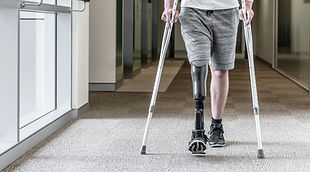

Total Hip Replacement
Home Physio specializes in diagnosing and carefully treating Total Hip Replacement while making sure each patient is fully informed throughout the process. Serving the Central, West & North London , Home Physio is known for delivering outstanding results while helping you minimize your personal investment and creating a suitable treatment plan for your needs.
Home / Conditions / Total Hip Replacement

Total Hip Replacement Exercise Guide
Regular exercise to restore strength and mobility to your hip and a gradual return to everyday activities are important for your full recovery after total hip replacement. Your orthopaedic surgeon and physical therapist may recommend that you exercise for 20 to 30 minutes a day, or even 2 to 3 times daily during your early recovery. They may suggest some of the exercises shown below.
This guide can help you better understand your exercise and activity program, supervised by your physical therapist and orthopaedic surgeon. To ensure your safe recovery, be sure to check with your therapist or surgeon before performing any of the exercises shown.

Early Postoperative exercises
The following exercises will help increase circulation to your legs and feet, which is important for preventing blood clots. They will also help strengthen your muscles and improve hip movement.
Start the exercises as soon as you are able. You can begin them in the recovery room shortly after surgery. You may feel uncomfortable at first, but these exercises will enhance your recovery and actually diminish your postoperative pain.
Ankle Pumps
-
Slowly push your foot up and down.
-
Repeat this exercise several times, as often as every 5 or 10 minutes.
-
If you are watching television, you should pump your feet every time a commercial comes on.
Begin this exercise immediately after surgery and continue it until you are fully recovered.
Ankle pumps
Ankle Rotations
-
Move your ankle inward toward your other foot and then outward away from your other foot.
-
Repeat 5 times in each direction.
-
This exercise should take 3 minutes.
-
Do 3 to 4 sessions a day.
Ankle rotations
Bed-Supported Knee Bends
-
Slide your foot toward your buttocks, bending your knee and keeping your heel on the bed. Do not let your knee roll inward.
-
Hold your knee in a maximally bent position for 5 to 10 seconds.
-
Straighten your leg.
-
Repeat 10 times.
-
This exercise should take 3 minutes.
-
Do 3 to 4 sessions a day.
Bed-supported knee bends
Buttock Contractions
-
Tighten your buttock muscles and hold to a count of 5.
-
Repeat 10 times.
-
This exercise should take 90 seconds.
-
Do 3 to 4 sessions a day.
Buttock contractions
Abduction Exercise
-
Slide your leg out to the side as far as you can and then back.
-
Repeat 10 times.
-
This exercise should take 90 seconds.
-
Do 3 to 4 sessions a day
Abduction exercise
Quadriceps Set
-
Tighten your thigh muscle. Try to straighten your knee. Hold for 5 to 10 seconds.
-
Repeat this exercise 10 times during a 10-minute period, rest one minute and repeat.
-
Continue until your thigh feels fatigued.
-
This exercise should take 2 minutes.
Quadriceps set
Straight Leg Raises
-
Tighten your thigh muscle with your knee fully straightened on the bed.
-
Lift your leg several inches. Hold for 5 to 10 seconds.
-
Slowly lower your leg.
-
Repeat until your thigh feels fatigued.
-
This exercise should take 2 minutes.
Straight leg raises
Standing Exercises
Soon after your surgery, you will be out of bed and able to stand. You will require help at first but, as you regain your strength, you will be able to stand independently. While doing these standing exercises, make sure you are holding on to a firm surface such as a bar attached to your bed or a wall.
Standing Knee Raises
-
Lift your operated leg toward your chest. Do not lift your knee higher than your waist. Hold for 2 or 3 counts.
-
Put your leg down.
-
Repeat 10 times.
-
This exercise should take 3 minutes.
-
Do 3 to 4 sessions a day.
Standing knee raises
Standing Hip Abduction
-
Be sure your hip, knee and foot are pointing straight forward. Keep your body straight. With your knee straight, lift your leg out to the side.
-
Slowly lower your leg so your foot is back on the floor.
-
Repeat 10 times.
-
This exercise should take 2 minutes.
-
Do 3 to 4 sessions a day.
Standing hip abduction
Standing Hip Extensions
-
Lift your operated leg backward slowly. Try to keep your back straight. Hold for 2 or 3 counts.
-
Return your foot to the floor.
-
Repeat 10 times.
-
This exercise should take 2 minutes.
-
Do 3 to 4 sessions a day.
Standing hip extensions











Early Activity
Soon after surgery, you will begin to walk short distances in your hospital room and perform light everyday activities. This early activity aids your recovery and helps your hip regain its strength and movement.
Walking
Proper walking is the best way to help your hip recover. At first, you will walk with a walker or crutches. Your surgeon or therapist will tell you how much weight to put on your leg.
_edited.png)





